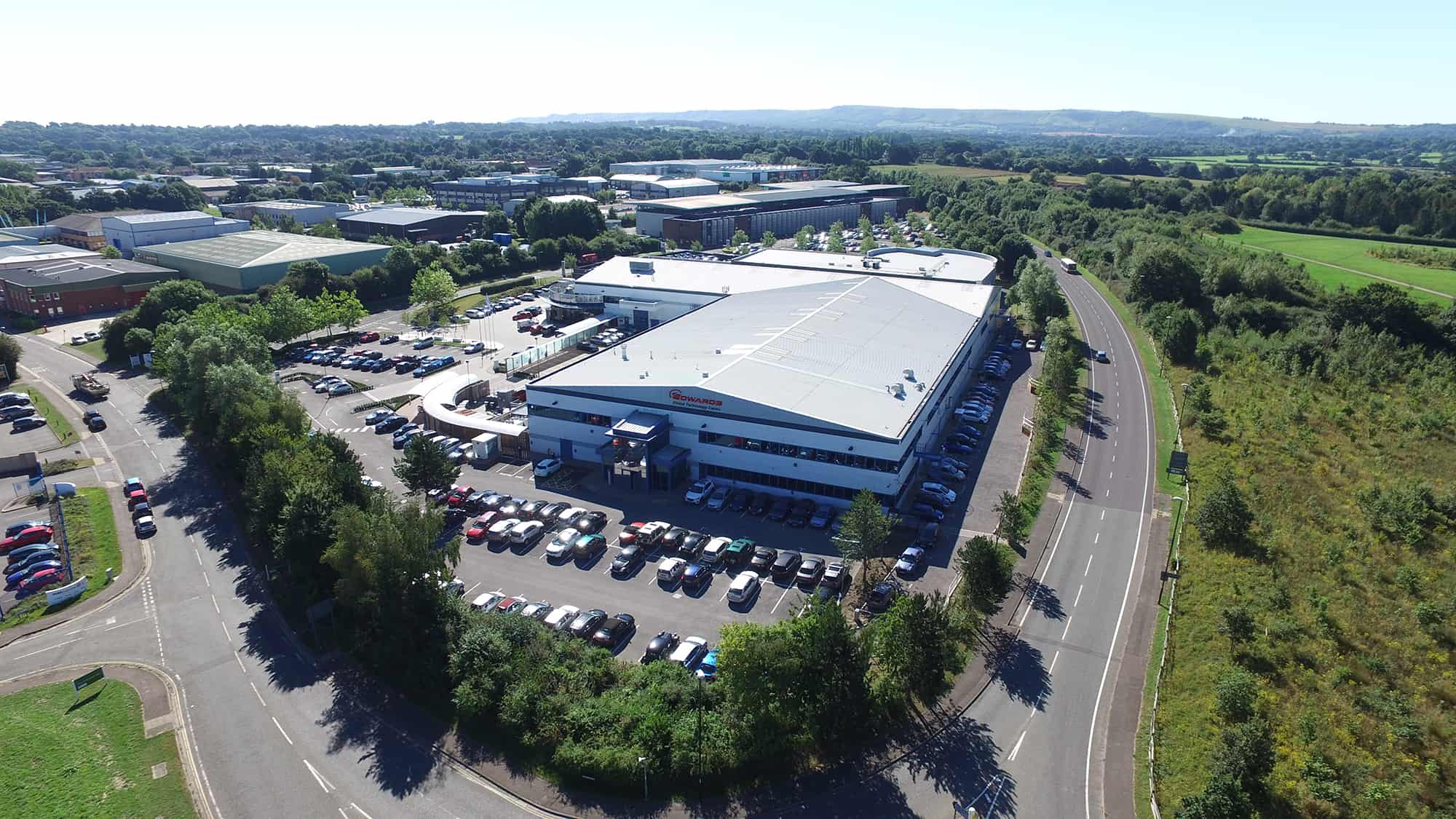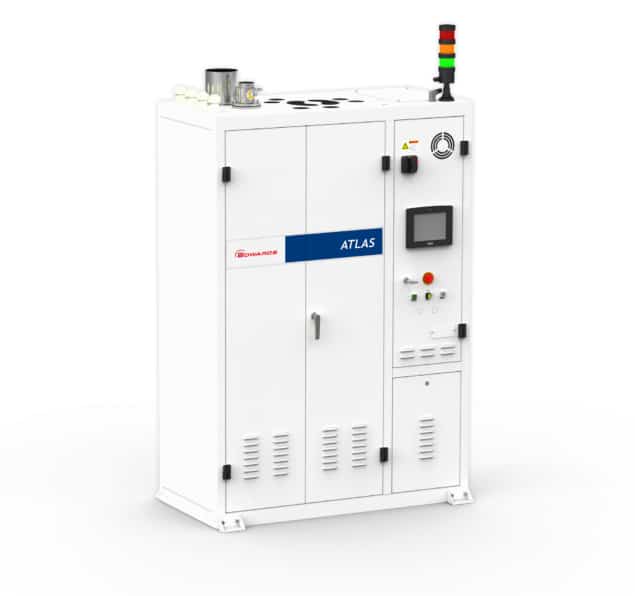Sara Fry from Atlas Copco talks to Hamish Johnston about the company’s plans to reduce its greenhouse gas emissions by 46% by 2030

The Swedish company Atlas Copco, which owns the Edwards vacuum instrumentation brand, has set science-based targets to reduce greenhouse gas emissions that are in line with the goals of the 2015 Paris Agreement on Climate Change. As well as aiming to reduce carbon emissions from the company’s direct operations by 46% by 2030 (compared to 2019 levels), the company has committed to reducing emissions in its supply and product chains. Sara Fry, who is Head of Safety Health Environment at Atlas Copco’s Vacuum Technique business area, which is in located in Burgess Hill, West Sussex in the UK, answers questions about the company’s plans.
Why has Atlas Copco set these targets?
Atlas Copco is committed to being part of the solution for a better tomorrow, so setting science-based targets to reduce greenhouse gas emissions in line with the Paris Agreement is a very public declaration of our ambition.
Science-based targets are targets set by companies to reduce their greenhouse gas emissions. The targets are calculated based on what we know from independent climate science, and they ensure that a company’s emissions are in line with the Paris Agreement. Setting high-ambition targets at the company level helps governments to achieve their targets and it shows our intention to contribute to limiting the global temperature increase. To ensure that we stay focused on our science-based targets, we have organizational key performance indicators for our direct and indirect emissions, which are reported annually.
What are the benefits to the company from setting the targets?
Playing a leading role in the transition to a low-carbon economy gives us a competitive advantage as we challenge ourselves to develop and deliver even more energy-saving solutions for our customers. We also reduce our risk of exposure to regulatory pressures due to carbon prices, which are expected to rise over time.
Having our targets validated by an independent organization, like the Science Based Targets Initiative (SBTI), also adds transparency and external credibility to our goals. The drivers for this come from within the organization and these targets are an extension of our long-standing commitment to reducing our environmental impact. Our employees have a keen interest in the environmental credentials of the company they work for, and of course customers and investors want to deal with companies that have strong sustainability programmes.
You have set a target of 46% for the company’s direct carbon reduction target, how will that be achieved?
If we are to succeed, it’s vital that everyone in the company understands what we are doing and why, so training and communication is important. Within Atlas Copco Vacuum Technique, all employees complete two online training sessions – one on our environmental goals in general and one specific to our science-based targets. In addition, we have been running a series of briefings for all senior site and divisional managers to ensure they are clear on our targets and what they need to do to support the effort.
We are also reducing our direct carbon emissions (known as scope 1 and scope 2 emissions), which mainly come from our use of electricity and natural gas. We are doing this by moving to low-carbon, renewable sources of energy – a journey that began several years ago. In 2021, 58% of all energy used in Atlas Copco operations was from renewable sources. As we implement our science-based targets, we will need to increase this further.

Our next challenge will be to eliminate the use of natural gas, which we mainly use for heating. One option is to move to electrically powered air- or ground-source heat pumps. We are also investigating the use of biogas generated from waste and accredited by renewable energy certificates.
We also have many local initiatives at our worldwide locations. At Vacuum Technique’s UK head office where I am based, for example, we offer a free shuttle to the railway station, electric vehicle charging points for employees, and we have just launched a salary-sacrifice programme to encourage employees to buy electric vehicles.
Can you give an example of how you are reducing carbon emissions related to the development and manufacture of vacuum components.
In Atlas Copco Vacuum Technique, our first manufacturing facility to use 100% renewable electricity was Gamma Vacuum in Shakopee, Minnesota, US, which achieved that goal four years ago. In 2021 we transitioned our large Edwards and CSK factories in South Korea to fully renewable energy, which reduced our annual carbon emissions by around 16 000 tonnes.
Today, we have moved nearly all our product companies to 100% renewable electricity backed by regulated renewable energy certificates. This is not always easy because in some countries there is limited availability of renewable electricity.
When we build a new factory, we design it to comply with a green building certification system, usually either LEED or BREEAM. This involves including features such as solar panels, high levels of insulation and rainwater harvesting.
Over 90% of the company’s indirect carbon emissions are from the electricity powering your products at customer locations. How are you helping customers reduce these emissions?
There are three main ways and the first is to provide the most energy-efficient products possible. Energy efficiency is at the core of the innovations in many of Atlas Copco’s products and even higher gains are possible through the support we provide on how to use our products and through our service offer.

One example is the Edwards iXM range, which is our latest low-power dry pump technology for the semiconductor industry. We can offer the low-emission benefits of the iXM range to customers with legacy equipment via our iXM Hybrid service upgrade. Pumps currently in use can be returned to a local service technology centre, where they are converted to use the iXM low power mechanism. The pumps are then re-installed with no change to customer connections or settings – and they use 25% less energy
The iXM Hybrid product is currently deployed at a world-leading semiconductor customer, and it has reduced their carbon emissions by around 700 tonnes in the first 20 months of operation. The same project could deliver a total reduction of around 13 000 tonnes at the completion of the full five-year deployment programme.
The second way we are helping our customers reduce emissions is by supplying intelligent systems to optimize energy use. For example, our Genius Portal allows 24/7 remote access to an operating vacuum pump. This provides customers with important insights into up-time and energy consumption. Similarly, Edcentra is an equipment monitoring and analytics platform for the semiconductor industry that analyses operational data to optimize performance and therefore reduce emissions.
The third way we minimize emissions associated with the use of our products is to work with customers to encourage their use of low-carbon, 100% renewable electricity. Indeed, many of our larger customers are already doing as part of their own environmental commitments.
In 2021, Atlas Copco’s installed base of abatement products prevented emissions of gases equivalent to around 19 million tonnes of carbon dioxide at customer facilities
What about the direct emissions of greenhouse gases by some of your customers?
Some semiconductor manufacturing processes use gases such as perfluorocarbons and sulphur hexafluoride, which are of high environmental concern because of their persistence and high global warming potential (GWP). These substances may have GWPs thousands of times higher than that of carbon dioxide, making them very potent global warming gases. Our Edwards and CSK ranges of abatement systems prevent the emission of these gases and help our customers reduce their emissions.
In 2021, Atlas Copco’s installed base of abatement products prevented emissions of such gases equivalent to around 19 million tonnes of carbon dioxide at our customers’ facilities. In addition, our partnerships in developing recycling technologies for our customers’ process gases can further reduce their carbon footprints.
What role does reuse and recycling play in your strategy?
Our organization’s second largest indirect carbon impact, after the energy use of products at customer locations, is the embodied carbon in the materials and components used to make our products. As a result, Vacuum Technique is committed to supporting the circular economy through the reuse, recovery and recycling of these materials.
Our business area has six divisions, and two of these are service divisions that are entirely focused on the remanufacture, repair and servicing of our products. When our products need replacing, we offer ways to refurbish them for reuse – we refurbish over 35 000 products each year.
At the end of their life cycle, our vacuum products can be disassembled so that their primary materials can be recycled – keeping them out of landfills. We also aim to reuse or recycle our production waste wherever possible. In 2021, 93% of all waste generated in Atlas Copco was reused or recycled.
Do you have carbon emissions in mind when you are developing new vacuum products?
Yes, we have a requirement that all new product developments include a target to minimize carbon emissions. Our engineering teams use a carbon footprint tool to calculate the lifetime emissions of new products and compare this to previous generations. The same tool can help customers determine the environmental benefits of upgrading to a newer design of product.
Finally, I would like to point out that our vacuum technologies enable the manufacturing of a wide range of environmentally friendly products that support the transition to a low-carbon society. For example, vacuum is essential to the production of solar cells and low-energy solid-state lighting.
You are a chartered member of the Institute of Physics, how does that fit with your work on sustainability and science-based targets?
I am a physicist by training, but when I first started working in the field of safety, health and environment many years ago, it seemed a long way away from physics.
However, in recent years the discipline has evolved to include sustainability and that’s closely linked to physical principles – whether it’s climate science, science-based targets and carbon accounting, or sustainable materials and sustainable buildings. So, there is a very close fit between being a member of the Institute of Physics and my current work.



